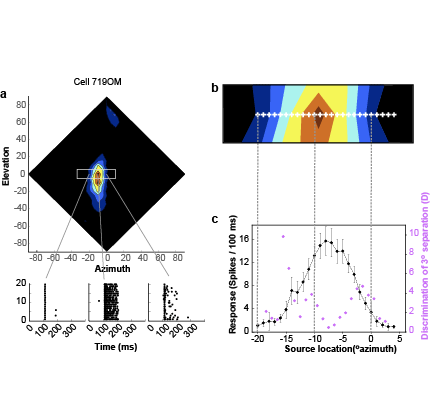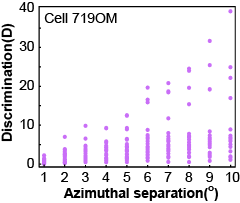

Azimuthal discrimination by a space-specific neuron (SSN). The barn owl mid-brain contains a map of auditory space, composed of SSNs that each respond to sounds from a small region of space. A typical spatial receptive field (SRF) of an SSN is shown in plot (a). Sounds presented from locations colored red elicit high rates of discharge, while sounds from black colored regions result in supression of spontaneous activity. Neuronal activity was measured at a resolution of 1° in azimuth (b) in a slice that ran through the peak of the SRF. The resultant azimuth tuning function (c) was used to compute the ability of this neuron to discriminate a 3° separation, which equals the behavioral threshold for spatial discrimination in azimuth.
The resultant discrimination function (D; standard separation) shows that resolution is best at the parts where the slope of the tuning function is maximal, and is poorest near the peak and at the floor of the tuning function.
The resultant discrimination function (D; standard separation) shows that resolution is best at the parts where the slope of the tuning function is maximal, and is poorest near the peak and at the floor of the tuning function.

The magenta symbols in plot (c) above show all the discrimination values possible for a single SSN across the azimuthal extent of its RF. Discrimination values for the same neuron (SSN 719OM) were calculated for sound source separations ranging from 1° to 10°. As with the 3° separation, discrimination values were highest where the slope of the RF was most steep. If we were to assume a homogenous space map, composed solely of neurons with response characteristics identical to that of 719OM, these discrimination values would represent the output of the map to source separations ranging from 1° to 10°. By computing such discrimination ranges from a large enough sample to be representative of the actual composition of the space map, we could derive an approximation of the output of the SSN population to any given source separation in azimuth.
to be continued...